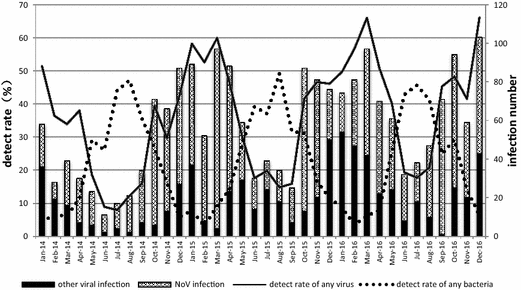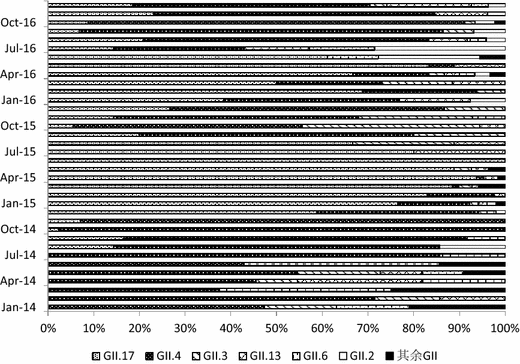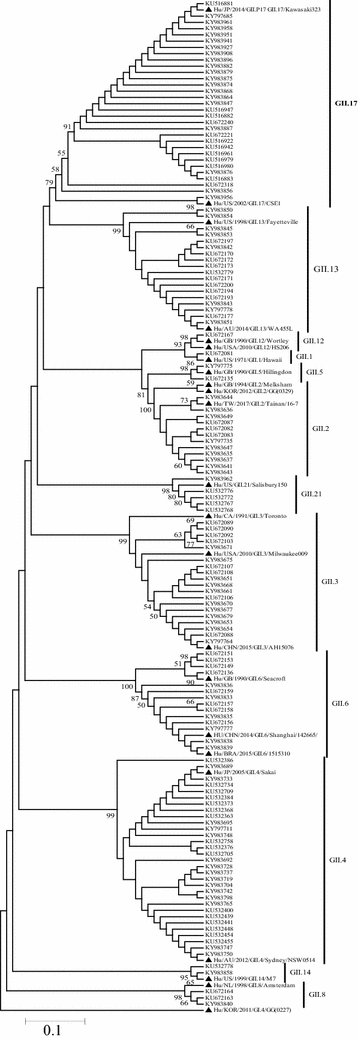Molecular epidemiology of genogroup II norovirus infections in acute gastroenteritis patients during 2014-2016 in Pudong New Area, Shanghai, China
- PMID: 29483945
- PMCID: PMC5824483
- DOI: 10.1186/s13099-018-0233-1
Molecular epidemiology of genogroup II norovirus infections in acute gastroenteritis patients during 2014-2016 in Pudong New Area, Shanghai, China
Abstract
Background: Norovirus (NoV), a member of the Caliciviridae, is now recognized as the leading cause of acute gastroenteritis (AGE) worldwide. Globally, the GII.4 Sydney_2012 variant has predominated in NoV-related AGE since 2012, although the novel variant GII.17 has also been reported as responsible for gastroenteritis outbreaks in East Asia since 2014. This study aimed to disclose the recent genotype patterns of NoV genogroup II (GII) presenting in AGE patients in Pudong New Area of Shanghai through a laboratory-based syndromic surveillance system. The study further aimed to delineate the predominant strains circulating in the population.
Methods: Pudong New Area is located in eastern Shanghai and covers 20.89% of the Shanghai population. The laboratory-based syndromic surveillance system is composed of 12 sentinel hospitals among the 68 general hospitals in this area. AGE patients who sought medical care were sampled following an AGE surveillance protocol. Stool samples were collected from participating patients, and a standardized questionnaire was given to each patient by trained nurses to gain information on the disease profiles and demographics of the patients. Real-time reverse transcription polymerase chain reaction (qRT-PCR) was used to screen the GI nd GII NoV and RT-PCR was used to amplify NoV GII partial capsid protein open reading frame 2 (ORF2). NoV Genotyping Tool (version 1.0, RIVM, MA Bilthoven, Netherlands) was used for genotyping, and a phylogenetic analysis was conducted by MEGA 7.0.
Results: During 2014-2016, among the 2069 virus-infected AGE cases, 65.88% were caused by NoV. NoV-AGE occurred most frequently in the periods from October to March. The patients with more severe diarrheal symptoms and vomiting were more likely to be infected by NoV. The main genotypes were GII.17 (44.69%) and GII.4 (39.26%), which dominated the NoV-AGE epidemics jointly or in turn, whereas a slight increase in GII.2 was observed beginning in May 2016. The GII.17 strains tended to cluster more with the Hu/JP/2014/GII.P17_GII.17/Kawasaki323 variants, representing novel prevalent strains. Among the GII.4 strains, the GII.4 Sydney_2012 variant was still the predominant strain.
Conclusions: NoV GII has become the main cause of virus-infected AGE in Pudong New Area, Shanghai. The predominant genotypes of NoV GII were GII.17 and GII.4. Comprehensive laboratory-based surveillance is important for clinical diagnosis and treatment. Identification of emerging new genotypes is also crucial for the prevention and control of NoV-infected AGE.
Figures



Similar articles
-
Molecular epidemiology of norovirus infections in children with acute gastroenteritis in 2017-2019 in Tianjin, China.J Med Virol. 2022 Feb;94(2):616-624. doi: 10.1002/jmv.27340. Epub 2021 Oct 1. J Med Virol. 2022. PMID: 34528724 Free PMC article.
-
Genetic diversity and epidemiology of Genogroup II noroviruses in children with acute sporadic gastroenteritis in Shanghai, China, 2012-2017.BMC Infect Dis. 2019 Aug 22;19(1):736. doi: 10.1186/s12879-019-4360-1. BMC Infect Dis. 2019. PMID: 31438883 Free PMC article.
-
Molecular epidemiology and genetic diversity of norovirus among hospitalized children with acute gastroenteritis in Tianjin, China, 2018-2020.BMC Infect Dis. 2021 Jul 14;21(1):682. doi: 10.1186/s12879-021-06375-2. BMC Infect Dis. 2021. PMID: 34261441 Free PMC article.
-
[The emergence of novel GII.4 norovirus variant, Sydney_2012, in Shanghai, China].Bing Du Xue Bao. 2013 Nov;29(6):608-14. Bing Du Xue Bao. 2013. PMID: 24520766 Chinese.
-
Genotypic prevalence of norovirus GII in gastroenteritis outpatients in Shanghai from 2016 to 2018.Gut Pathog. 2019 Jul 26;11:40. doi: 10.1186/s13099-019-0321-x. eCollection 2019. Gut Pathog. 2019. PMID: 31372183 Free PMC article.
Cited by
-
Age, primary symptoms, and genotype characteristics of norovirus outbreaks in Shanghai schools in 2017.Sci Rep. 2018 Oct 15;8(1):15238. doi: 10.1038/s41598-018-33724-0. Sci Rep. 2018. PMID: 30323290 Free PMC article.
-
Molecular epidemiology of norovirus infections in children with acute gastroenteritis in 2017-2019 in Tianjin, China.J Med Virol. 2022 Feb;94(2):616-624. doi: 10.1002/jmv.27340. Epub 2021 Oct 1. J Med Virol. 2022. PMID: 34528724 Free PMC article.
-
Prevalence and associated factors of norovirus infections among patients with diarrhea in the Amhara national regional state, Ethiopia.BMC Infect Dis. 2024 Sep 27;24(1):1053. doi: 10.1186/s12879-024-09988-5. BMC Infect Dis. 2024. PMID: 39333942 Free PMC article.
-
Prevalence of noroviruses in children hospitalized for acute gastroenteritis in Hohhot, China, 2012-2017.BMC Infect Dis. 2019 Jul 9;19(1):595. doi: 10.1186/s12879-019-4230-x. BMC Infect Dis. 2019. PMID: 31288749 Free PMC article.
-
Epidemiological and clinical differences between sexes and pathogens in a three-year surveillance of acute infectious gastroenteritis in Shanghai.Sci Rep. 2019 Jul 10;9(1):9993. doi: 10.1038/s41598-019-46480-6. Sci Rep. 2019. PMID: 31292502 Free PMC article.
References
-
- Eurosurveillance editorial team Collective. WHO launches the World Health Statistics 2012. Euro Surveill. 2012;17(20):20175. - PubMed
LinkOut - more resources
Full Text Sources
Other Literature Sources

